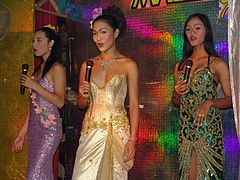
Back كاثوي Arabic কাথোয়ে Assamese Kathoey Catalan Kathoey Czech Kathoey Welsh Ladyboy Danish Kathoey German Kathoey Esperanto Kathoey Spanish Ladyboy Estonian
This article has multiple issues. Please help improve it or discuss these issues on the talk page. (Learn how and when to remove these messages)
|
 Kathoeys on the stage of a cabaret show in Pattaya | |||||
| Pronunciation | [kàtʰɤːj] | ||||
|---|---|---|---|---|---|
| Meaning | Trans women, intersex, androgynous people, effeminate gay men | ||||
| Classification | Gender identity | ||||
| Other terms | |||||
| Synonyms | Ladyboy, phuying praphet song, phet thi sam, sao praphet song | ||||
| Associated terms | Bakla, Khanith, Kothi, Hijra, Two-spirit, Trans woman, Akava'ine | ||||
| Demographics | |||||
| Frequency | up to 0.6% male (2011 estimate)[citation needed] | ||||
| |||||
| Legal information | |||||
| Recognition | Yes, limited | ||||
| Protection | None | ||||
| Part of a series on |
| Transgender topics |
|---|
|
|
Kathoey or katoey (Khmer: ខ្ទើយ, khtəəy; Lao: ກະເທີຍ, ka thœ̄i; Thai: กะเทย; RTGS: kathoei, Thai pronunciation: [kàtʰɤːj]), commonly translated as ladyboy in English, is a term used by some people in Cambodia, Laos, and Thailand, whose identities in English may be best described as transgender women in some cases, or effeminate gay men in other cases. These people are not traditionally transgender, but are seen as a third sex. Transgender women in Thailand mostly use terms other than kathoey when referring to themselves, such as phuying (Thai: ผู้หญิง, 'woman'). A significant number of Thai people perceive kathoey as belonging to a separate sex, including some transgender women themselves.[1]
In the face of the many sociopolitical obstacles that kathoeys navigate in Thailand, kathoey activism has led to constitutional protection from unjust gender discrimination as of January 2015, but a separate third gender category has not yet been legally recognized.[2]
- ^ Winter, Sam (2003). Research and discussion paper: Language and identity in transgender: gender wars and the case of the Thai kathoey. Paper presented at the Hawaii conference on Social Sciences, Waikiki, June 2003. Article online Archived 29 March 2012 at the Wayback Machine.
- ^ Cite error: The named reference
Yeung-2017was invoked but never defined (see the help page).